
IEEE 1394
The Cable Connection to Complete
The Digital Revolution
In the beginning there was analog, and the worldwas good. But discontent grew among those who heard hiss and rumble in the land of audio, and the digital compact disc became the standard. Between the microphone and the audio amplifier, audio data now remained in a digital form, and the cry was heard, digital is good, analog is out.
Over in the land of video, an envious eye saw digital audio users editing audio recordings over and over with no quality deterioration. The land of video proclaimed, digital is good, analog is out, and digital video editing became the standard. Computing devices converted the analog video from a video camera into a digital form, edited the digital video, and finally converted the video back into analog for a VCR or television. But all was not well. Video cameras became digital themselves but had to convert their digital video into analog for output to a cable. The device at the other end of the cable then converted the analog video back into digital for editing. Each analog/digital conversion deteriorated image quality so the land of video proclaimed, the video signal must remain digital on the cable.
A gathering of the elders decided that a new way of transporting digital data was needed. Being wise and future thinking, the elders formed a standards committee, an IEEE standards committee, so that each member could communicate its digital data and all would be compatible. Since 1,393 standards had already been considered, their efforts were called IEEE 1394. Several of the elders from the house of Apple preferred a less numeric name and called their version of IEEE 1394, FireWire.
Thus, the IEEE 1394 High Performance Serial Bus came into being and is now revolutionizing the transport of digital data for consumer and professional electronic products, communications, and computers. By providing an affordable, high-speed, non-proprietary interconnect for all digital devices, a truly universal connection is now available.
IEEE 1394's main features are:
-
It is available today and is supported by more than 40 member companies of the 1394 Trade Association
-
It is a low-cost cross-platform solution standardized for transporting all types of digital data
-
Its easy-to-use cable and connector allows users to attach or remove devices at any time
-
100 Mbps (Million bits per second) operation transports compressed video today, while 200 Mbps operation by 2Q96, and 400 Mbps by 1997 will handle all multimedia data. Gigabit speeds (1 Gbps = 1000 Mbps) and beyond are already on the design board
-
Asynchronous data transport provides connectivity to legacy technology such as printers and modems, and provides command and control for new devices
-
Isochronous data transport guarantees delivery of multiple, time-critical, multimedia data streams
IEEE 1394 is not the answer to all digital transport solutions. For example, Intel's USB (Universal Serial Bus), with its 12 Mbps transport rate, may be a less expensive solution when speed is not critical, as in connecting a keyboard and mouse to a computer. Alternatively, optical fiber exceeds IEEE 1394's data transport rate, but has additional complexity and cost. In the marketplace of transporting digital audio and video, the 100 Mbps to 1+ Gbps spectrum, IEEE 1394 is therefore the most cost effective solution.
But Why a Serial Bus?
At first glance, a parallel cable might make more sense to transport large amounts of data since there are more wires to carry signals -- wouldn't eight cables in parallel transport eight-times the data of a single serial cable? Well, yes to a point, but other factors come into play.
A serial bus provides a simple point-to-point connection allowing scalable capability with technology improvements. A serial cable and its connector are less expensive to manufacture and requires less room than a parallel cable -- a quality not lost on the manufacturers of laptop computers, where every square inch of space is at a premium.
A parallel cable has more electrical interference between the multiple wires, the physical cable size is larger and more expensive since there are more wires and shielding, and synchronization between wires can be a problem at higher speeds.
The bus issue is more complex. IEEE 1394 may be used as a network in limited situations, but its operation and price point are not optimized for full scale network operation. A bus connects lots of peripherals easily and inexpensively and its data transmission commands are simple and straightforward, such as a write to the address of the peripheral or a read from its address.
The IEEE 1394 Cable
The IEEE 1394 cable contains six copper wires: two wires carry power and the other four wires are grouped into two twisted-wire signal pairs. Each twisted pair is shielded as is the entire cable.
 The power wires carry between 8 to 40 VDC at up to 1.5 amps, and are used to:
The power wires carry between 8 to 40 VDC at up to 1.5 amps, and are used to:
-
maintain a device's physical layer continuity when the device is powered down or malfunctions--very important for a serial topology
-
provide power for devices connected to the bus
The only required cable going to a device therefore could be the IEEE 1394 cable as it provides both data transport and power -- a great convenience for the user.
 The cable connector is constructed such that the electrical contact is made inside the structure of the connector, thus preventing any shock to the user or contamination of the contacts by the user's hands. This small and flexible connector is very durable and easy to use even in situations where the user must blindly insert it into the back of a device. There is no cable terminator required or addressing ID to be set.
The cable connector is constructed such that the electrical contact is made inside the structure of the connector, thus preventing any shock to the user or contamination of the contacts by the user's hands. This small and flexible connector is very durable and easy to use even in situations where the user must blindly insert it into the back of a device. There is no cable terminator required or addressing ID to be set.
A second cable design has emerged that is smaller and lighter than this cable. Currently used on the Sony Digital Video Handycams, this four-wire cable does not contain the power wires.
Up to 63 IEEE 1394 devices may be connected to a bus segment. Each device may be up to 4.5 meters apart with longer distances possible with repeater hardware. There is current design activity to extend this distance to 25 meters. Over 1000 bus segments may be connected by bridges, thereby providing a large growth potential.
An IEEE 1394 device may be added to or removed from the bus at any time--even with the bus in full operation. Upon altering the bus configuration, there is an automatic reassignment of node addresses. This plug and play feature eliminates the need for address switches or other user intervention when reconfiguring the bus.
A Typical Application
Consider the example of a digital video camera sending digital video data to a digital monitor and to a computer, which is connected to both a digital VCR and a printer.
 Since the video carried on the IEEE 1394 cable is digital, each device can process the video directly in the digital domain without the expense and image quality loss incurred when converting back and forth to analog video. There is no need for a video capture card or any analog-to-digital video conversion -- the entire data path is digital. The monitor, computer, and VCR accepts the digital data and displays or stores the data as is appropriate. A video frame could be sent to the printer for hard copy.
Since the video carried on the IEEE 1394 cable is digital, each device can process the video directly in the digital domain without the expense and image quality loss incurred when converting back and forth to analog video. There is no need for a video capture card or any analog-to-digital video conversion -- the entire data path is digital. The monitor, computer, and VCR accepts the digital data and displays or stores the data as is appropriate. A video frame could be sent to the printer for hard copy.
Control data, such as powering on the video camera, is transmitted by asynchronous mode from the computer, or even the television. The actual video data is transmitted in isochronous mode; a direct pipe line of data from the camera to the other IEEE 1394 devices. This mode can guarantee just-in-time delivery of data since there is no collision detection or other arbitration scheme involved.
New device paradigms may occur. An IEEE 1394 printer could be radically different from those currently on the market. Given the great increase in speed for sending data from the computer to the printer, this printer could be less complex and less expensive than current models as all print rasterization could be performed in the computer and sent directly to the print head in final form.
Riding the Information Super-Highway

One proposed
solution of transporting the great quantities of data required for the Information
Super-Highway is ATM (Asynchronous Transport Mode). ATM is the phone system
of the future and is excellent for transporting data, but it can be expensive
to attach to every device in the office or home. IEEE 1394 is inexpensive
and has a packet structure similar enough to ATM to allow bridging. By designing
IEEE 1394 to be the local connection for ATM networks, IEEE 1394 can be
the first 10 feet and last 10 feet of the Information Super-Highway.
The 1394 Trade Association
The 1394 Trade Association was formed in September, 1994, to accelerate the market adoption of IEEE 1394. Of special importance are the technical working groups that focus on extending the IEEE 1394 specification. The Trade Association is composed of 41 member companies including Sony, Mitsubishi and Matsushita from the consumer electronics field; Apple Computer, IBM, Sun and Microsoft from the computer industry; Texas Instruments, National Semiconductor, Advanced Micro Devices and Cirrus Logic from the semiconductor industry; and Skipstone for IEEE 1394 developer tools and OEM solutions.
If you are interested in IEEE 1394, the 1394 Trade Association is where you should be. To get information, browse the Association's Internet Web server at http://firewire.org. To join, contact Gary Hoffman, chairperson of the 1394 Trade Association and CEO of Skipstone, at gary.hoffman@skipstone.com or call the 1394 Trade Association at 512-305-0223.
The Coming-Out Party
The Fall 95 COMDEX trade show was the first major public declaration of IEEE 1394 support. The 1394 Trade Association organized a large demonstration room at COMDEX to show off its members' products. Sony demonstrated its DCR-VX1000 and DCR-VX700 Digital Video cameras with IEEE 1394 output, Texas Instruments showed off its new 200 Mbps Physical Link chips and a prototype IEEE 1394 front end for a printer, Molex featured its IEEE 1394 cable technology, Apple demonstrated a prototype digital video system, and Skipstone showed its second generation IEEE 1394 developer software and computer adapter as well as a prototype IEEE 1394 front end for a Mitsubishi video monitor.
Sony's own booth contained a large theater showing their vision of the home of the future featuring IEEE 1394 as the digital data transport medium. In Mitsubishi's booth, they and Skipstone presented Mitsubishi's Home Multimedia Network, again featuring IEEE 1394.
The Challenge at Hand
To allow IEEE 1394 to live up to its potential, there is still much work ahead. Microsoft's recent announcement of Windows 95 support for IEEE 1394 validates the computer market's involvement, but no schedule has been announced for such support. Sony already has IEEE 1394 products on the market, but no product announcement schedule is available from the other manufacturers.
Behind all of this, the 1394 Trade Association is evolving the IEEE 1394 standard to include improved capabilities and functionality, as well as maintaining order over its member companies to produce fully compatible products.
And finally, IEEE 1394 is a data transport standard, not a content standard. To be usable, the format of the content carried over IEEE 1394 must be agreed to, which represents another standards process. For example, Sony has defined a digital video format for transport over IEEE 1394, while Yamaha is working on a digital audio format for IEEE 1394.
A Road Map to the Future
In early 1995, Skipstone provided its first generation IEEE 1394 developer toolkit to assist manufacturers in adding IEEE 1394 capability to their products. Sony's announcement in late 1995 of its Digital Video Handycams with IEEE 1394 capability represented the first IEEE 1394 consumer products.
Mid-year 1996 will see IEEE 1394 computer video adapters for Digital Video cameras, thus allowing the first cost effective way to capture, edit, and store digital video. Professional and high end audio and video enthusiasts will embrace IEEE 1394 for its ability to move vast amounts of digital data at 200 Mbps.
By 1997, consumer electronics and computer manufacturers will offer 400 Mbps IEEE 1394 solutions, matched by the inclusion of IEEE 1394 into popular operating systems. The public will quickly notice that IEEE 1394 opens new cost-effective ways of moving multimedia data.
By 1998, gigabyte IEEE 1394 devices will be on the market, and IEEE 1394 will be a pervasive technology.
Internet Web Sites for IEEE 1394 Information
-
1394 Trade Association: http://firewire.org/
-
Skipstone: http://www.skipstone.com/
-
Sony: http://www.sel.sony.com/SEL/consumer/camcorder/dcr_vx1000.html
-
Texas Instruments: http://www.ti.com/sc/docs/msp/1394/1394.htm
Daniel Moore
Skipstone, Inc.
Tel. 512-305-0200
Fax 512-305-0212
dan.moore@skipstone.com
http://www.skipstone.com
Skipstone is a trademark of Skipstone, Inc. All other trademarks are the property of their respective companies.
To the Editor, 21st
A statement in the "Why FireWire is HOT! ..." 21st article concerns me. It's the statement attributed to a National Semiconductor (NSC) design brief that indicates there is a design issue WRT reducing jitter of MPEG-2 streams that possibly requiring large amounts of buffering. This might be old information. This topic was examined and answered well over a year ago, and NSC was a part of the team who did that work, mostly within the 1394 Trade Association.
There is in fact a problem with transporting MPEG-2 over any non-dedicated (i.e. shared) transmission system. The MPEG-2 transport specification *appears* to allow only +/- 500 nsec of variation in the transport delay, but any shared media system will introduce delays of some sort. This is true for 1394, for ethernet, and especially so for ATM. I said *appear* because there is some confusion interpreting the language in the MPEG-2 transport standard.
The solution for 1394 is to add a 1394 system time stamp to the packets which
allows the jitter to be canceled to a value of about +/-85 nsec. The buffering
required to do this is under 1 kByte, which in my mind does not qualify as "large
amount."
Thanks & regards,
Alan Wetzel
1394 Product Development Team
Mixed Signal Products Division
Texas Instruments, Inc.
PO Box 660199, M/S 8710
Dallas TX. 75266-0199
Voice: 214-480-2155
FAX: 214-480-3160
email: awetzel@ti.com
http://www.ti.com/sc/1394
21st, The VXM Network, https://vxm.com